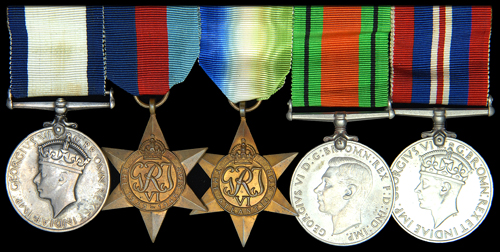
Auction: 8023 - Orders, Decorations, Medals & Militaria
Lot: 61
x The ´Immediate´ Dieppe Raid C.G.M. Group of Five to Ordinary Seaman T.A. Lee, Royal Navy, For His Outstanding Courage as Part of the Gun Crew of LCT (Landing Craft, Tank) 127 at ´Red Beach´, Where She Was Subjected to Devastating Mortar and Shell Fire for Approximately 15 Minutes, Rendering All of Her Gun Crew Killed or Wounded. Ordinary Seaman Lee Finally Crawled Away From His Post and Reported to His C/O Just as They Were About to Withdraw: "I can´t do anything else for you Skipper"; His Left Leg was Later Amputated a) Conspicuous Gallantry Medal, G.VI.R. (JX.299940 T.A. Lee. O.Smn.) b) 1939-1945 Star c) Atlantic Star d) Defence and War Medals, first slightly worn, therefore generally nearly very fine, mounted as originally worn (5) Estimate £ 25,000-30,000 C.G.M. London Gazette 2.10.1942 Ordinary Seaman Thomas Albert Lee, C/JX 299940 (Dieppe) The Recommendation, dated 26.8.1942, states: ´´This rating was one of the gun crews of the 2 pdr Pom Poms on L.C.T. 127. Whilst the craft was beached for about 15 minutes the guns were kept continually in action against an enemy gun position and houses on the beach until all the guns crews had been killed or wounded. Lee´´s cheerful example and courageous devotion to duty were an example to the remainder. When finally the guns were silenced Lee, although seriously wounded, crawled to his C.O. Skipper McPherson and said "I can´´t do any more for you skipper." This rating has since had his left leg amputated.´´ Thomas Albert Lee, C.G.M., served as an Ordinary Seaman in LCT (Landing Craft, Tank) 127 for the Commando Raid on Dieppe, 19.8.1942. LCT 127 was part of the first wave of LCTs to attempt to land tanks in support of the full frontal assault force on the main Dieppe Beach, ´´This frontal assault, a bloody climax to the events on the other beaches, had always been the most controversial part of the operation. Even to the amateurs planning the Dieppe operation, there was something uniquely hazardous about making a frontal assault on the beach at Dieppe. It smacked of another Light Brigade at Balaclava, or a Pickett´´s Charge at Gettysburg - in boats.´´ (The Dieppe Raid, R. Neillands refers). The main beach was split into the eastern landing area codenamed ´´Red Beach´´, close to the harbour entrance, and the western landing area codenamed ´´White Beach´´. Red Beach was to be assaulted by the Essex Scottish, and White Beach which encompassed the Casino that occupied the promenade between the houses and the sea wall was to be the objective of the Hamilton Light Infantry, ´´Both units would be followed by thirty Churchills from the Calgary Tanks equipped with machine-guns and 6-pdr guns, landing in three waves directly onto the shingle.´´ (ibid). The beach at Dieppe was nearly a mile in length, and dominated by headlands. The beach ended in a sea wall with a 6 and half foot thick barbed wire obstacle. There was approximately a 200 yard stretch between the beach and the seafront buildings. At the western end of the beach was the Casino which had been fortified by the Germans, with the addition of two pillboxes. The headlands overlooking the beach were dotted with machine-gun sites and support weapon positions, many dug into embrasures, making them difficult to dislodge and also putting them in a perfect position to create a natural ´´killing ground´´ below on the beach. All the roads leading away from the beach were blocked by high and thick concrete walls, many of which were covered by machine-guns or anti-tank guns. The supporting destroyers included in the naval part of the assault force opened up on the sea front before moving their fire to the headlands, whilst the R.A.F. bombed the headlands, before laying smoke over the positions to cover the landings. The first wave of troops landed at 05.23 and quickly made its way up the beach and through the first line of barbed wire. By the time they reached the sea wall things had started to take a turn for the worst. The naval bombardment had failed to damage the German defensive positions on the headlands, who now turned their attention to the assault force on the beach. The crossfire created from the positions on the headlands combined with the pillboxes and snipers along the seafront to devastating affect. The supporting tanks were to supposed to land in conjunction with the infantry, however, the latter were left cruelly exposed for 10-15 minutes before the first wave of three LCTs (including LCT 127) arrived, ´´The first tank wave landing on Red Beach consisted of three LCTs, each containing three Churchill tanks. These tanks had been equipped with a rolled-up bundle of wooden palings, a primitive form of carpet, which, it was hoped, would provide some grip for the tank tracks on the rolling shingle of the beach.... The first LCT [145] managed to unload its three tanks under fire but while these armoured vehicles - named ´´Calgary´´, ´´Company´´ and ´´Chief´´ - got off unscathed to grind about the beach, the LCT was so damaged and holed by shellfire that it sank as it pulled back off the shore. The second craft [LCT 126] grounded and was then delayed, well aground and under a storm of fire, because the tank crews had failed to warm up their engines before the landing and the cold engines refused to start - a small error that had a grievous effect. Frantic minutes passed while the three tanks remained stuck on the launching ramp, tanks and LCT under heavy fire. When the second three tanks - ´´Cat´´, ´´Cougar´´ and ´´Cheetah´´ - finally got off their riddled craft, they quickly found a place where the shingle had piled up against the sea wall... The LCT had by now lost its bow door, and most of the crew were killed or injured before it could reverse off the beach and pull out to deeper water; those on board were taken off by the destroyer Slazak before this LCT sank.´´ (Ibid) The third LCT to try to land was Lee´´s. LCT 127 was grounded for the longest of the three landing craft, and was subjected to the same intense fire for approximately 15 minutes, ´´Pte. A.M. Sinclair, the Toronto Scottish machine-gunner on the other side of LCT 2, counted 17 hits by mortar bombs in 16 minutes, "My remaining ammunition was so riddled by shrapnel as to be useless,´´ he said. The naval personnel manning the Bofors guns were all killed or wounded within a few minutes. O/S Thomas Lee crawled away from his post and reported to Lt. McPherson, "I can´´t do anything more for you skipper". Afterwards Lee had his left leg amputated". (Dieppe 1942 - The Jubilee Disaster, R. Atkin refers). Despite this horrendous punishment from the German positions, LCT 127 managed to deliver its tanks and slowly limp away to relative safety. The Second wave of LCTs received similar attention from the German heavy guns, LCT 159 was hit while approaching the shore but managed to deliver her three tanks before being hit again and disabled. LCT 121 shared the same fate. LCT 163 tried to land its cargo four times, succeeding on the last attempt. The third wave of four LCTs arrived about half an hour after the first two waves, losing one of its number and having another crippled. The force of LCTs managed to land 28 out of the 30 tanks allocated to the operation, ´´the gallantry of the LCT crews in this part of the operation should not be forgotten. Ten LCTs had gone in; five of them were promptly sunk by shell fire and another three were badly damaged; 50% of the LCT crews were either killed or wounded.´´ (The Dieppe Raid, R. Neillands refers). The investiture ceremony for Lee´´s C.G.M. took place 18.5.1943. His C.G.M. is 1 of only 2 awarded for the Dieppe Raid.
Sold for
£36,000




